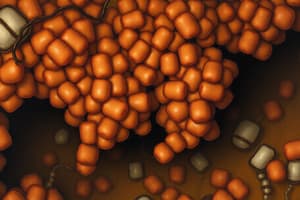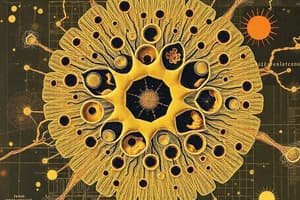Podcast
Questions and Answers
What is the primary role of the Golgi apparatus?
What is the primary role of the Golgi apparatus?
- Photosynthesis
- Protein maturation and sorting (correct)
- Genetic information storage
- Cell division
What are the two named networks within the Golgi apparatus?
What are the two named networks within the Golgi apparatus?
- Plasma-Golgi Network and Endoplasmic Network
- Cis-Golgi Network and Trans-Golgi Network (correct)
- Cytosolic Network and Nuclear Network
- Rough-Golgi Network and Smooth-Golgi Network
Which of the following is NOT a function of the Golgi apparatus?
Which of the following is NOT a function of the Golgi apparatus?
- Maturation of glycolipids
- Sorting molecules
- Synthesis of ATP (correct)
- Processing of proteins
How does the Golgi apparatus participate in glycosylation?
How does the Golgi apparatus participate in glycosylation?
What type of reactions do molecules undergo in the Golgi apparatus?
What type of reactions do molecules undergo in the Golgi apparatus?
What role does the trans-Golgi Network (TGN) serve?
What role does the trans-Golgi Network (TGN) serve?
Which enzymatic process occurs during protein maturation in the Golgi?
Which enzymatic process occurs during protein maturation in the Golgi?
What is continuously happening to the vesicles in the Golgi apparatus?
What is continuously happening to the vesicles in the Golgi apparatus?
What is the primary role of the Golgi complex in cells involved in active secretion?
What is the primary role of the Golgi complex in cells involved in active secretion?
What type of vesicles are involved in transporting materials from the rough endoplasmic reticulum (RER) to the Golgi complex?
What type of vesicles are involved in transporting materials from the rough endoplasmic reticulum (RER) to the Golgi complex?
Which type of coated vesicle is primarily responsible for transporting lysosomal enzymes?
Which type of coated vesicle is primarily responsible for transporting lysosomal enzymes?
What is the role of COP-I coated vesicles within cellular transport?
What is the role of COP-I coated vesicles within cellular transport?
What determines the specific packaging of proteins into vesicles?
What determines the specific packaging of proteins into vesicles?
Which of the following vesicle types is involved in maintaining specificity within the Golgi complex?
Which of the following vesicle types is involved in maintaining specificity within the Golgi complex?
Where is the Golgi complex particularly well developed in cells?
Where is the Golgi complex particularly well developed in cells?
What type of movement do COP-I coated vesicles mainly facilitate?
What type of movement do COP-I coated vesicles mainly facilitate?
What is the primary function of the Golgi complex in eukaryotic cells?
What is the primary function of the Golgi complex in eukaryotic cells?
How does the arrangement of cisternae in the Golgi apparatus appear?
How does the arrangement of cisternae in the Golgi apparatus appear?
Which face of the dictyosome is oriented towards the endoplasmic reticulum (ER)?
Which face of the dictyosome is oriented towards the endoplasmic reticulum (ER)?
What is a characteristic of cells with extensive Golgi complexes?
What is a characteristic of cells with extensive Golgi complexes?
What distinguishes the cisternae at the cis face from those at the trans face?
What distinguishes the cisternae at the cis face from those at the trans face?
How many cisternae are typically found in each dictyosome in animal cells?
How many cisternae are typically found in each dictyosome in animal cells?
What term describes the interconnectedness of dictyosomes within the Golgi apparatus?
What term describes the interconnectedness of dictyosomes within the Golgi apparatus?
What does the term 'dictyosome' specifically refer to?
What does the term 'dictyosome' specifically refer to?
What role does glycosylation play in protein processing?
What role does glycosylation play in protein processing?
Which carbohydrates are synthesized by the Golgi apparatus?
Which carbohydrates are synthesized by the Golgi apparatus?
Where does O-glycosylation begin in the cell?
Where does O-glycosylation begin in the cell?
What process is responsible for the separation of daughter plant cells during cytokinesis?
What process is responsible for the separation of daughter plant cells during cytokinesis?
What determines blood groups in red blood cells?
What determines blood groups in red blood cells?
How do Golgi-derived vesicles contribute to the formation of the cell wall in plant cells?
How do Golgi-derived vesicles contribute to the formation of the cell wall in plant cells?
Which component of glycosylation provides specificity for protein targeting?
Which component of glycosylation provides specificity for protein targeting?
What triggers the increase in the number of Golgi bodies in plant cells?
What triggers the increase in the number of Golgi bodies in plant cells?
Flashcards
Golgi Complex
Golgi Complex
A stack of flattened, disk-like, membrane-bound sacs called cisternae, involved in processing, packaging, and sorting proteins and lipids.
Cis Face
Cis Face
The convex side of the Golgi complex facing the endoplasmic reticulum (ER).
Trans Face
Trans Face
The concave side of the Golgi complex facing the plasma membrane, where processed molecules exit.
Dictyosomes
Dictyosomes
Signup and view all the flashcards
Golgi Polarization
Golgi Polarization
Signup and view all the flashcards
Golgi in the Endomembrane System
Golgi in the Endomembrane System
Signup and view all the flashcards
Golgi Complexity and Secretion
Golgi Complexity and Secretion
Signup and view all the flashcards
Golgi Functions
Golgi Functions
Signup and view all the flashcards
Golgi Apparatus
Golgi Apparatus
Signup and view all the flashcards
cis-Golgi Network (CGN)
cis-Golgi Network (CGN)
Signup and view all the flashcards
trans-Golgi Network (TGN)
trans-Golgi Network (TGN)
Signup and view all the flashcards
Glycosylation
Glycosylation
Signup and view all the flashcards
N-linked Glycosylation
N-linked Glycosylation
Signup and view all the flashcards
O-linked Glycosylation
O-linked Glycosylation
Signup and view all the flashcards
Phosphorylation
Phosphorylation
Signup and view all the flashcards
Sulfation
Sulfation
Signup and view all the flashcards
Cytokinesis in plants
Cytokinesis in plants
Signup and view all the flashcards
Phragmoplast
Phragmoplast
Signup and view all the flashcards
Polysaccharides
Polysaccharides
Signup and view all the flashcards
Glycolipids
Glycolipids
Signup and view all the flashcards
Golgi Sorting
Golgi Sorting
Signup and view all the flashcards
COP-II coated vesicles
COP-II coated vesicles
Signup and view all the flashcards
COP-I coated vesicles
COP-I coated vesicles
Signup and view all the flashcards
Clathrin-coated vesicles
Clathrin-coated vesicles
Signup and view all the flashcards
Address Codes
Address Codes
Signup and view all the flashcards
Retrograde Transport from Plasma Membrane
Retrograde Transport from Plasma Membrane
Signup and view all the flashcards
ERGIC (ER-Golgi Intermediate Compartment)
ERGIC (ER-Golgi Intermediate Compartment)
Signup and view all the flashcards
Study Notes
Golgi Complex Structure
- The Golgi complex, also known as the Golgi body or Golgi apparatus, was discovered in nerve cells by Camillo Golgi.
- It's found in all eukaryotic cells.
- The complex consists of flattened, disc-like cisternae with dilated rims, associated vesicles, and tubules.
- Cisternae are typically 0.5-1 µm in diameter and arranged in stacks resembling a shallow bowl.
- Each stack of cisternae is called a dictyosome, containing several cisternae.
- Animal cells typically have several dictyosomes, while plant cells can have up to twenty.
- The Golgi body can consist of one or several dictyosomes.
- Dictyosomes are interconnected by tubules, working together in a coordinated manner.
- The Golgi apparatus is part of the endomembrane system.
Golgi Complex Function
- The Golgi apparatus is responsible for the maturation and sorting of proteins, glycoproteins, carbohydrates, and glycolipids.
- Proteins, carbohydrates, and lipids travel through cisternae in a dictyosome, undergoing specific maturation reactions.
- These reactions include trimming by proteolytic enzymes, modification of N-glycosylation state, hydroxylation, and sulfation.
- O-glycosylation, which adds carbohydrates to proteins, occurs within the Golgi complex.
- Carbohydrate and protein synthesis inside the Golgi complex is initiated in the RER and modified in the Golgi.
Golgi roles in glycosylation
- The assembly of carbohydrate motifs on glycoproteins starts in the RER and continues in the Golgi.
- The Golgi complex utilizes specific enzymes to remove and replace monosaccharides on N-linked oligosaccharides.
- O-glycosylation, a different type of glycosylation, occurs only within the Golgi.
- The Golgi's three compartments contain diverse enzymes that aid in the different glycosylation reactions
Golgi complex in secretion and sorting
- The Golgi complex plays a crucial role in maturation and packing secretory products in secretory cells.
- It's responsible for producing lysosomes, organelles containing hydrolytic enzymes.
- Golgi complex sorts, packages, and transports proteins and lipids to their final destinations.
- Specialized vesicles (e.g., coated vesicles like COPII and COPI) are involved in the transport of materials to and from the Golgi complex and other organelles.
- Proteins destined for secretion or incorporation into the plasma membrane are packaged into vesicles from the Golgi that then fuse with respective membranes.
- Some proteins are delivered back to the ER to complete their synthesis or modification.
- The Golgi plays a role in the formation of the cell wall in plant cells.
Golgi Complex in Polysaccharides Synthesis
- The Golgi complex synthesizes complex carbohydrates like glycosaminoglycans for the extracellular matrix, as well as hemicellulose and pectin for plant cell walls.
- The Golgi is essential for the formation and secretion of cell wall components, separating daughter cells during plant cell division.
- Golgi-derived vesicles migrate along microtubules to the equatorial plate for cell wall deposition during cytokinesis.
- Synthesizes cell components such as cellulose in situ.
Golgi Complex in Lipid Processing
- The Golgi apparatus processes lipids, including glycolipids determining blood group antigens.
- These glycolipids are transported in vesicles for integration into the plasma membrane.
Studying That Suits You
Use AI to generate personalized quizzes and flashcards to suit your learning preferences.



